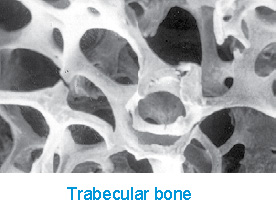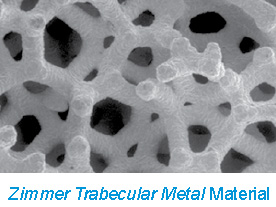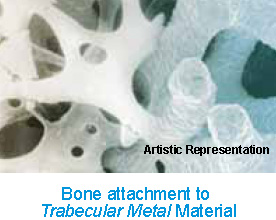


Your bone—dynamic living organs
The 206 bones in your body may seem rock solid, but they are actually dynamic living organs composed of five main parts:
- Compact Bone or Cortical Bone is the hard, strong, solid outer layer, which gives bone its whitish color.
- Periosteum is a thin membrane that coats the compact bone. It contains nerves and blood vessels that provide bone tissue with nourishment and feeling.
- Trabecular (porous) Bone is found inside the hard outer layer. It is porous (filled with holes like a sponge) and contains bone marrow. Trabecular bone is made up of a mesh-like network of tiny pieces of bone called trabeculae.
- Bone Marrow is found in many, but not all of your bones. It is located inside the Trabecular bone and performs the important function of making most of your red and white blood cells and platelets.
- Subchondral Bone is the smooth tissue at the ends of bones, which you know as cartilage.
Inspired by bone
Named after Trabecular bone, Zimmer® Trabecular Metal Material is a unique, highly porous biomaterial made from tantalum designed with structural and functional properties similar to those of Trabecular bone. Trabecular Metal Material acts as a structural scaffold that allows existing bone and tissue to grow right onto it—providing greater biologic fixation.
Revolutionary new material
For years, titanium was the gold standard in orthopedic implants. But now, elemental tantalum, the core material used to create Trabecular Metal Technology, has benefits above and beyond that of traditional titanium, especially when utilized as a porous ingrowth material. It is extremely strong yet has the flexibility similar to that of Trabecular (porous) bone. Trabecular Metal Material can be used to create an entire implant resembling normal bone, unlike other porous joint replacement materials that can only be coated or sprayed onto an implant surface. Trabecular Metal Technology is currently used with knee, hip and spine products.
